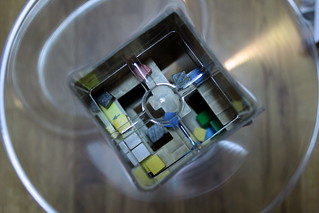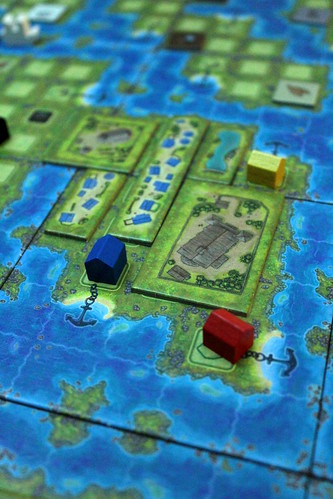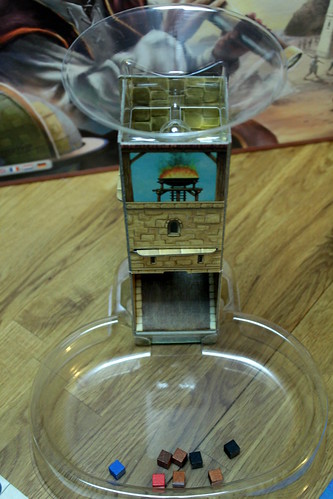| Strategy | Luck |
|---|---|
| Interaction | Components & Design |
| Complexity | Score |

At the start of the game, you drop all 49 cubes – seven each in seven colors – into the top to seed the tower, making a very satisfying amount of noise. Everything that falls out again is sorted to the appropriate spaces on the storage board, making it easy to see what is still hidden in the tower. Each turn, the start player takes all cubes of one color from the storage board and drops them in the tower. What falls out at the bottom determines which actions can be taken this turn. Each player then performs one action, all cubes that fell from the tower are sorted back to the storage board, then you repeat with the next color on the storage board. Since there are seven colors of cubes, you take seven actions for one round. The game lasts 5 rounds, so 35 actions is all you get. By that time, whoever lives in that tower must be furious.
The cubes falling out of the tower tell what you can do in two ways: for any color that fell out, you can take the associated action this turn, but the highest number of cubes of the same color tells you how many action points you have. Each action taken by itself is simple and straightforward, so you never wait long between your turns.

The blue action, for example, lets you move both your ships on the game board. This map of the new world is wonderfully variable, arranging the 16 tiles (less with fewer players) creates very different seascapes, sometimes with many small island, other times with two or three large ones only. The board’s geography is not only irrelevant background, either, different setups favor very different approaches to scoring. But in a game about the exploration of the Americas, all strategies need you to actually move your ship, so lets get back to that. For each action point, blue let you move both your ships by one square. A ship finishing its movement on a square marked with an anchor can build a trading post on the land square next to it, your first foothold on an island.
That was fast, but the black action is even faster: for each action point you move your cannon marker up by one square. The cannons are important because, at the end of each round, players are attacked by more and more powerful pirates. Any player who can’t defend himself by matching the pirates’ strength with cannon fire is robbed by them and loses their strength in victory points. And still loses all his cannons, too. Apparently, telling your men to just let the pirates murder them so you can defeat them next round doesn’t work, they still try to fight back. Loading your cannons is the action you are most likely to forget until it’s too late, it doesn’t really do anything good on the board. But losing ten points to pirates is painful, and there is another benefit to charging your cannons, too: going beyond the end of the cannon track is immediately rewarded with two gold coins which can buy action points when you need them.

Action red is part one of a little tile-laying element in Amerigo. You want to completely cover islands with landscape tiles to score points. Before you can do that, you must buy the tiles, that’s exactly what happens here. You can buy as many of your own village tiles as you want for one action point each, or you can buy the much more expensive neutral tiles which also score many more points. But for now, you only put those tiles next to your player board, placing them is a different action.
But this is not yet it. Brown has nothing to do with those tiles, instead it lets you advance one space per action point on the progress track. Passing certain checkpoints there is worth victory points, but also and more importantly allows you to take one of the progress tokens. Those handy, beautiful, little things can have all kinds of beneficial effects. One type gives you additional action points whenever you pick a specific color, another can be used once for a huge pile of action points, or for money, or to immediately become the new start player. One especially nasty token makes the pirates stronger by two points for everyone except you. Some of these tokens also award extra points at the end of the game. Really, their only downside is that you can not pick more than five of them in the whole game.
Green is where we get back to the tiles. For the same amount of action points that they cost to buy, you can now place them on the board. Rules of common sense apply here, so no overlapping, no tiles partially in the ocean and so on. Covering a commodity token – cotton, tobacco, sugar cane, coconuts or coffee – lets you take that token, worth points later in the game. But placing tiles also scores points right now, and for the neutral tiles it’s not even little points. A six-square neutral on a big island scores 18 points. Even better if that tile covers the last free spaces of an island, because then the island scores, too. All players with trading posts here receive points based on how many they have and which round it is. The earlier the better, and since the round bonus is a multiplier it’s really worthwhile to finish an island with two or three ports in the first round. The division into buying and placing tiles seems odd at first, but it makes sense in play. It also opens the way to playing like a bastard, it’s not all that hard to prevent your opponents from placing those expensive six-square tiles when you can see that they bought them.

Yellow is easier again, for yellow action points you can buy one of the available production markers. They show the same symbols as the commodity markers and act as multipliers for those. Commodities are worth (Number of Commodity Tiles) x (Number of Production Tiles + 1) points, which equals approximately a metric ton if you collected all you could in one or two commodities. Specialisation does pay off here, it’s better to get as many tiles as you can grab of one or two types than just getting whatever is in your way, without any planning.
Finally, the white action is a bit of an odd duck. I don’t know what makes ducks odd, but the white action is one. Maybe it doesn’t like water. When you pick white, you have two options what to do. Either you advance on the special action track – which could have done with a better name, but I can’t think of one, either – or you use your special action. The special action track has multiple functions. Being first on this track makes you the start player. Advancing on this track is worth points when the game ends. And the color of your space on this track gives you your special action. You may use white cubes to perform the action associated with the color of your special action spot. Advancing here is always a bit tricky, every time you need to decide if your priority is going far for points and player order, or stay on a space of the color that is most useful to you. Unless you are in the lead already, that’s not usually an easy decision.
In general, easy decisions are rare in Amerigo. In that way, it’s a classic Feld game as I’ve come to love them. Every decision is agony, because what you want to do is not what you should do – namely load your cannons – and you often brood about the contents of the dice lighthouse: “I have to pick yellow before this round is over so I can buy that production marker, but if I do it now I waste 2 action points. There are three more yellow cubes in the tower, so maybe I should move my ships now and wait for the next one to drop …” and so on. It’s never easy, there’s never an ideal decision, it’s always a trade-off. Because of that, I like Amerigo better than the last two Feld games I tried, Bora-Bora where virtually everything you did was worth some points and Bruges where I didn’t feel like my decisions made a difference. Here, you do make decisions, and they do matter. And there’s no best way to do anything, either. Different strategies yield comparable amounts of points, you can try very different ways to play and still discover ways to win. The geography plays into this a lot, so from game to game which strategy has the best chances doesn’t stay the same. You have to think again every time.

Amerigo is almost up there with Macao, still my favorite Feld design. It doesn’t quite push it off the throne, but it has a similarly delicate balance between luck and strategy. You can manage your luck, but just barely, and there’s always some nail-chewing if you’ll be able to get that last action you desperately need or not. A minor annoyance in that whole “managing your luck” thing is that, sometimes, cubes get stuck in the lighthouse and will not be seen again for the rest of the game. It’s not a big issue, but having three green cubes missing for the whole game makes a dent in some strategies, and by the time you realize what is happening it may well be too late. But that’s my only gripe about the components as well, Amerigo is a typical Queen Games game in component quality: good-looking and sturdy. It should be mentioned that it’s also huge, the box is almost the size of my car. Really, leave it on the sidewalk for a minute and you may come back to find a parking ticket on it. Why you would leave it on the sidewalk, I have no idea. It’s not a game that you would want to get rid off, especially if you like Stefan Feld’s typical mix of luck, strategy and horrendously painful decisions. With games like this one coming out of Queen Games’ Kickstarter projects, I will keep an eye on their projects.














